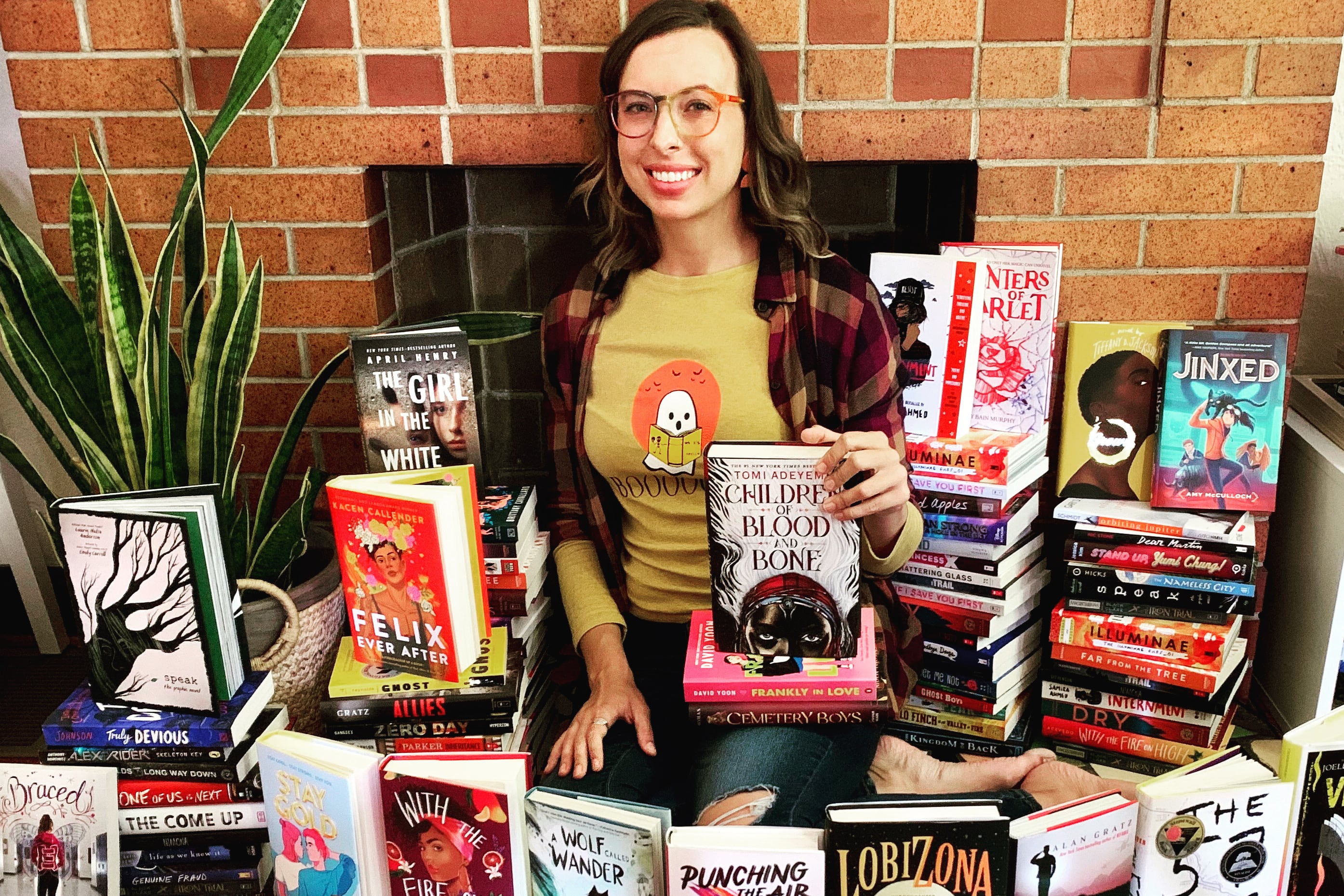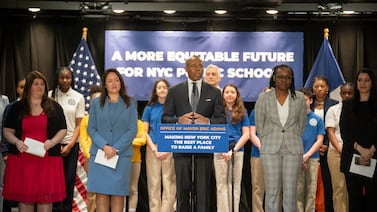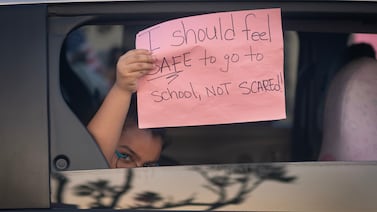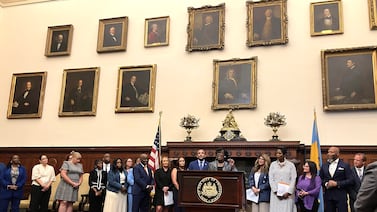During the pandemic, Chalkbeat published dozens of essays that spoke to the tumult of COVID-era teaching. Lindsay Klemas wrote about teaching on Zoom while caring for a toddler. Canwen Xu recounted what it was like to be a first-year educator at the height of COVID. Walt Stallings wrote about the particular vulnerability of substitutes during school closures, and George Farmer discussed the challenge of building parent-teacher relationships from a distance.
In one memorable Chalkbeat essay, Katie Kraushaar, now Katie Hicks, wrote that the pandemic revealed that “to teach is to martyr.” When educators returned to classrooms after lockdowns, many of them struggled, Hicks said. “Schools are relying on the mental well-being of teachers,” she wrote, “and there’s not enough to go around.”
Two months later, Hicks — then a middle school English teacher in St. Louis — announced on Twitter, now X, that she had reached a tipping point. Her exit after 12 years in the field was part of a broader exodus of teachers following COVID school closures. Several states experienced record teacher turnover, and some schools reported unprecedented mid-year exits.
Hicks said while she still loved her students and her colleagues, she hated what school had become. “I could blame the pandemic, politics, parents or some other word that starts with the letter P,” she wrote on Twitter. “But it doesn’t really matter. I needed to break up with teaching.”
These days, Hicks lives in Florida and works in health care advocacy. Despite her career change, “who I am as an educator shows up every single day: in how I am raising my son, in my current profession outside of education, in how I treat and interact with other people,” she told Chalkbeat. In an interview coinciding with the fifth anniversary of the COVID school closures, Hicks reflected on what communities have come to expect from teachers, how educators showed up for each other during pandemic schooling, and what school leaders can do to support teachers who are facing burnout.
Why did you become a teacher, and what kept you in the classroom for 12 years?
When I was in high school, I took an advanced literature course. A lot of my classmates came to me for help understanding some of the pieces we read, as well as feedback on their writing. I realized I really enjoyed breaking apart literature and explaining it in ways that people understood, so I decided to pursue education as my major.
Love kept me in the classroom for a dozen years. I loved my subject — English Language Arts — and I loved working with middle schoolers. I also loved the unpredictability and everythingness of teaching: No two days were the same. Teaching allowed me to reinvent myself and try new things, as well as the freedom to put my own personal spin on how I taught standard information. It was an avenue of self-expression for me.
How did COVID change what was expected of teachers?
Teachers have always had to wear many different hats: graphic designer, therapist, childhood development expert, etc. COVID increased those hats tenfold. I was responsible for checking on children who had ghosted and hadn’t logged in for weeks to our virtual classes, and I was left to worry whether their absence was due to simply not wanting to attend or if something more traumatic had happened to them or their family.
I had to quickly learn how to make online learning engaging — and it’s very different from in-person teaching. I couldn’t rely on body language, movement, or any other shared experiences to capture my students’ attention. I had to use memes and videos and pray that my persona translated across Zoom. When the 2020-2021 school year started, I had never met my students in person. They only knew me as a two-dimensional video of a person surrounded by the tiny Zoom box. Building rapport required a whole new playbook, but true relationships felt impossible.
How did those changing expectations affect your daily reality?
At the beginning of the pivot to virtual school, teachers showed up. We’re scrappy by nature, innovators who can make a lesson plan out of a few pieces of paper, glue, and a little magic. The pandemic was a challenge: How can we make school feel like a safe space? How can we create community without being together physically?
At first, I, like most of my fellow educators, rose to the challenge. When I realized that independent reading goals were all but moot for students who didn’t have access to fresh, engaging books, I organized a fundraiser to buy a book for each child in my English classroom. I worked with a local bookstore and surveyed my students so that I could efficiently play book matchmaker.
When our school hosted a drive-thru school supplies pick-up, I was able to meet some of my students in real life. I remember lowering my mask briefly to flash a smile as I handed their specially chosen book to them. The smiles I received back were definitely a high point. Things felt manageable then.
But it didn’t last. As we transitioned back to in-person learning, my morale — along with many of my colleagues — began to deteriorate. Our immense efforts during virtual school were quickly forgotten by the public, replaced with scathing criticism. We weren’t being stringent enough on the mask mandates. Or we were reprimanding them for not wearing their masks. We were juggling how to make in-person learning with social distancing rules work while simultaneously preparing engaging lessons for our students who chose to stay virtual for the duration of the 2020-2021 school year.
Every day, I got home from school and lay in my bed to rest my eyes and try to turn my brain off. But the laundry list of what I felt like I should be doing kept growing longer and longer, and the media’s portrayal of teachers didn’t help.
In 2022, you wrote in Chalkbeat that “schools are relying on the mental well-being of teachers, and there’s not enough to go around.” Why do you think the COVID era was so detrimental to teachers’ mental health?
I think COVID showed the cracks in our educational system in a big way.
There was a lot of surface-level support for teachers at the beginning of the pandemic — lots of social media graphics shouting their love for educators and discounts from fast food chains. Very similar to the “normal times” Teacher Appreciation Week, which is typically a lackluster affair for teachers where we’re reminded that we’re about as valuable as a coupon for an ice cream cone.
The best way I can put it: Imagine putting on a performance every single day for a room that is supposedly full of people, but you can’t see them at all. They’re shadowed. You can’t hear their reactions. You have no idea if what you’re saying makes any sense or resonates. That’s what teaching felt like during the pandemic, performing for a black sea of Zoom boxes with their cameras turned off. And it still felt that way when we were back in person: No one was truly “turning their camera on.”
How did teachers show up for each other during this time?
We took turns bearing the load for each other. We shared our snazzy slide decks with each other. When we found a new online tool that worked with virtual teaching, we didn’t gatekeep and instead shared our logins. Though it was easy to forget that teachers also were navigating the impacts of COVID on their personal lives, we recognized the struggle in each other and worked to take things off of the plate of someone who had to quarantine for 14 days due to a family member testing positive. We reminded each other to take breaks, take deep breaths, and take our time trying to figure it all out.
Was there a moment when you realized that it was time to break up with teaching? What emotions came with that decision?
When I first became a teacher, I swore up and down I would not be one of those tired, burned-out teachers who popped in a movie, kicked back, and checked out. I’m proud to say I never got even close to that point, but post-pandemic, there were moments when I understood how and why teachers ended up there. And it wasn’t because they were bad teachers. They were tired.
It felt wiser and better to me to leave before I became truly jaded and disconnected from my why, the reason I stayed in teaching so long. I believed that I made a difference. I believed that what I was doing mattered.
The last day before I left my school for good, my students and fellow teachers threw me a goodbye luau. I wore a silk lei, a grass skirt, and a silly hat. I took pictures with my students and hugged them goodbye. They wished me luck “on the island.” (I was moving to the U.S. Virgin Islands at the time.) I felt that glimmer of making a difference in that last moment before I hung up my teaching hat, and for a second, I wondered if I was making a mistake.
What advice would you give to school leaders who want to support the stretched-thin teachers in their schools?
My best advice is to think big. Look at the systemic issues and seek systemic change, not band-aid fixes that temporarily buoy teachers.
Know that this is much, much harder than putting chocolate on our desks or hiring a massage therapist to sit in the staff room for a day. Self-care is not the answer. I would argue that championing ways for teachers to practice self-care puts the onus back on us to fix a broken system by reducing the real, systemic issues down to simply needing to take a few deep breaths.
We need leaders who are committed to change, even when it’s hard and unpopular. And we need leaders who have been teachers and who understand the unique challenges associated with standing in front of a classroom.
Gabrielle Birkner is the features editor and fellowship director at Chalkbeat. Email her at gbirkner@chalkbeat.org.







